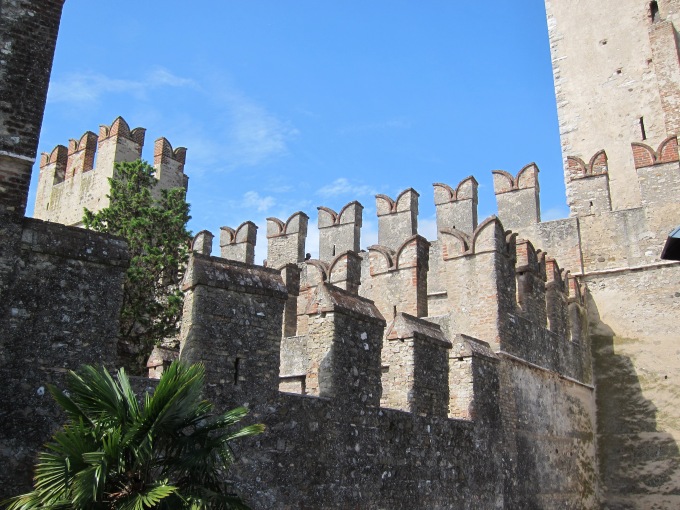
The “Rapid” Ferry
When we planned this vacation, Lake Garda's Simio Peninsula, Sirmione, and its Roman villa ruins became a magnet, and we scheduled a day trip back into history to visit an ancient vacation site of extremely wealthy Roman citizens.
Planes, Trains, and Automobiles - But We Choose the Ferry System
About 15 minutes from our hotel is the village of Saló, the location of the ferry service docks. The ferry system offers scenic lake steamers or the more time efficient hydrofoils; all depending on your time constraints and budget. We opted for the hydrofoil and caught the noon boat with two other stops before our destination. As we pulled away from the dock, we began to notice whitecaps and a slight swell in the water which once again reminded us of the vast size of this lake. An hour later we were pulling into the docks at Sirmione.
A Brief History of Sirmione
The peninsula has a very long history, but we will spare you… in summary it went from a fishing village in the stone ages, to a vacation destination in the 1st century for very wealthy and powerful families from Verona, to a strategic military defensive position with a fortress in the 13th century, to an obsolete castle fortification in the 15th century that eventually became a storage facility by the 19th century.
Lemons Into Limoncello
After all that turbulence the inhabitants of Sirmione settled down to an idyllic agrarian life filled with olive trees, fruit orchards and lake fisheries. But at the end of the 19th century, some enterprising individuals, using a metal pipe, figured out a way to tap into a thermal spring on the peninsula.
Let’s see… we have hot (158* F) mineral spring water, a castle, a collection of old churches, a piece of land with beautiful vistas on the largest lake in Italy topped off with a fairly intact Roman villa/bathhouse ruins...a new tourist attraction was reborn on the peninsula.
A Stretch, but Marketing Wins Over Accuracy
Their creative, entrepreneurial minds went into overdrive and the main attraction was now named the “Grottoes of Catullus”. They took some liberties, as there was actually no grotto, but only a series of rundown buildings with collapsed walls and some caves. In addition, as far as the Catullus part goes…the villa was created circa 150 AD and the famous Italian poet Catullus had died almost 200 years before the villa was built - but that did not stop the show. So tourism found Sirmione, and crowds returned to this ancient village, now complete with a medieval castle, three churches, spa hotels, thermal baths, restaurants, shopping areas and of course the famous Roman villa/ bathhouse ruins.
First Impressions of Sirmione:

Port of Sirmione

The main plaza near the dock area
The main plaza is right off the dock area and lined with souvenir shops and the more or less usual tourist dining options.

Lost-in-translation dining

Traditional got our vote

Typical and wonderful alfresco dining
Rocca Scaligera (Scaliger Castle)
After a short walk from the plaza, we found the advertised “fairy-tale-like-castle”… the 13th-century Scaliger Castle, surrounded by a moat and can be entered by two drawbridges, built to ward off invaders (and also the local peasants).



Distinctive “swallowtail merlons” adorn the castle walls

Interior wall and docking area
Twelve euros ($15) and about 20 minutes later, we had “seen” the castle and walked the walls. Onward to the next landmark…and in search of the ruins as the signage was quite limited. After working our way through the ever present crowds in the old town, we spied an electric train that offered rides from the thermal spas to the entrance of the ruins.
We observed that the crowds focused on the old town shopping and restaurant areas, the Scaliger Castle, and the three small churches (Sant’Anna della Rocca, San Pietro in Mavino, and Santa Maria Maggiore). The farther we were from those locations, the sparser the crowds. So going the extra mile paid off, as the ruins were pretty much empty of foot traffic.

The electric train
For one euro per person in each direction… a good deal as it is over a one kilometer walk up hill.

From Museo di Sirmione display
Grotte di Catullo (Grottoes of Catullus)
The grounds around the old villa ruins are about five acres in a parklike setting with wonderful vistas in every direction. Finally we found the "it-was-worth-the-trouble-to-get-here” moment - and none too soon.
The entrance to the area was through a very well done archaeological museum that had exceptional displays in a multi floored structure.






The Boat Back to Saló
We returned to the dock area a little before our scheduled ferry back to Saló as it was the last one for the day and we did not want to miss it. There was an alternative ferry service called the Taxi Boat Sirmione, but it came with a premium price tag.
Forming queues for anything in Italy is always an interesting experience. The tourists usually maintain something like a line, while the Italians simply merge at the gate. So when the ferry approaches the dock, all forms of discipline go out the window. Some refer to this as chaos; we just smile, tighten the ranks and shuffle along.
In Summary
Our adventure on Lake Garda was coming to a very positive conclusion and our last dinner at the Hotel Bolsone Dimora was an exceptional culinary treat and perfect ending to our visit.
We are departing for Sestri Levante in the morning and heading farther south to the Ligurian Coastline and the Mediterranean Sea. Please follow us as we continue our “Ultimate European Road Trip Series” - Part Ten - Sestri Levante / Liguria Italy.
After all, what is the hurry… be inspired.
© 2016 Inspired Travel Itineraries with Bob and Janice Kollar
© 2016 Picture Credits Bob & Janice Kollar
Comments